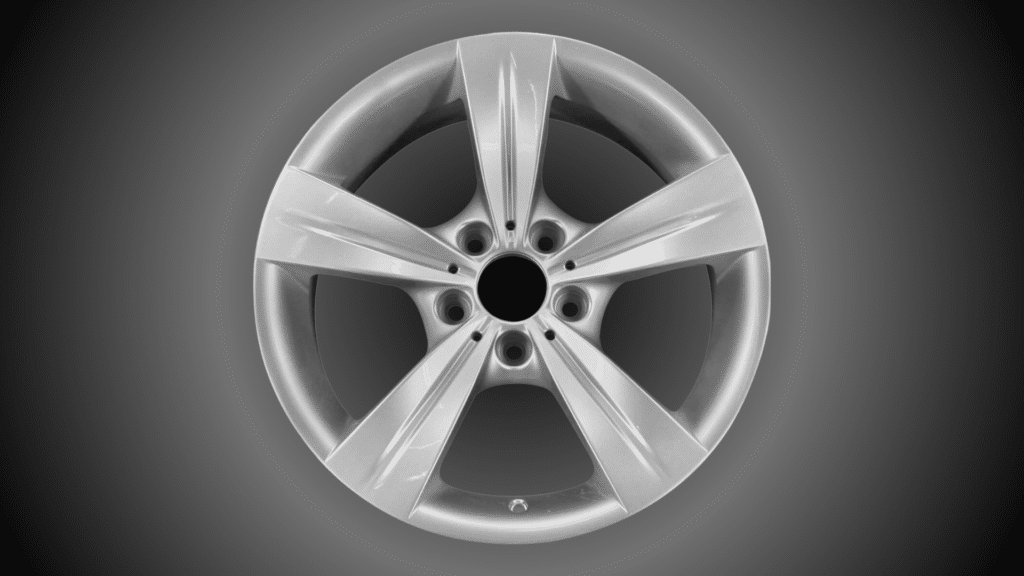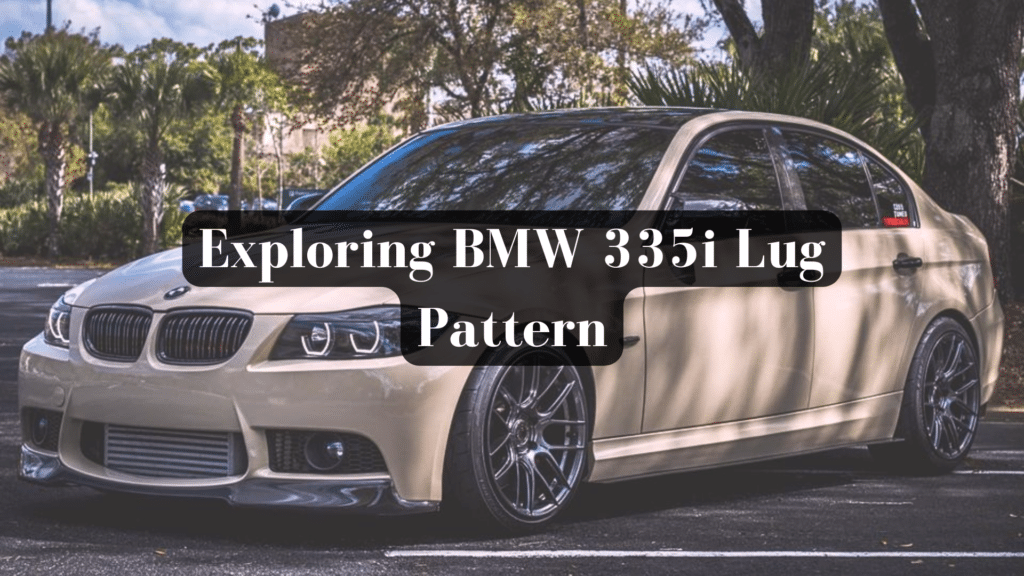Looking for the right wheels for your BMW 335i?
Let me help you understand the lug pattern – it’s simpler than you might think.
I’ve worked with BMWs for 8 years, and I’ll tell you exactly what you need to know about the 335i’s lug pattern.
Getting this wrong can cost you money and time, or worse, put your safety at risk.
Here’s what you’ll learn:
- The exact lug pattern measurements for your 335i
- How to check your current pattern
- Compatible wheel options
I’ve made the mistakes, learned the lessons, and tested different setups.
This guide gives you the facts without the fluff.
By the end, you’ll know precisely what works for your BMW 335i and what doesn’t.
What is the Lug Pattern for the BMW 335i?

A lug pattern tells you how your wheel fits onto your car.
Think of it as a fingerprint – each car model has its specific pattern.
The BMW 335i uses a 5×120 lug pattern. Let me break this down for you:
- The “5” means there are 5 lug holes
- The “120” shows the distance in millimeters between opposite lugs
Why does this matter?
If you put wheels with the wrong pattern on your car, they won’t fit properly.
This isn’t just about looks – it’s about your safety on the road.
I’ve seen many BMW owners get confused when shopping for new wheels.
Remember: All 335i models from 2007 to 2013 use the same 5×120 pattern.
Think of lug patterns like puzzle pieces.
You can’t force the wrong piece to fit – you need the right match. When you know your BMW’s pattern, you can:
- Buy the right wheels the first time
- Avoid costly returns
- Keep your car safe on the road
In the next section, let me help you measure your current pattern so you can be 100% sure about your fit.
How to Identify the Correct Lug Pattern for a Specific BMW 335i
1. Check Your Car’s Manual
Start with your BMW’s manual – it’s the easiest way.
Look in the wheels and tires section.
I always tell my customers to check here first because it saves time and prevents mistakes.
2. Look at Your Current Wheels
If you can’t find your manual, look at your current wheels.
Turn your wheel to the side. Count the number of lug nuts – you’ll see five of them.
Then, measure between two opposite lugs.
You should get 120mm for the 335i. I’ve done this hundreds of times, and it takes just a few minutes.
3. Use the VIN Number Method
Your Vehicle Identification Number holds all your car’s details.
Find it on your dashboard near the windshield or inside your driver’s door.
Call any BMW parts department with this number.
They can tell you the exact pattern. I use this method when I need to double-check specs.
4. Measure It Yourself
Here’s my tried-and-true method to measure your lug pattern:
- Place a measuring tape at the center of one lug hole
- Stretch it to the center of the opposite hole
- Measure in millimeters
- You should get 120mm for your 335i
5. Use Online Tools
Put your BMW’s year and model into trusted car parts websites.
They’ll show you the pattern.
But remember – I always suggest double-checking these results against your actual measurements.
Pro tip: Take a photo of your measurements.
This helps when you’re shopping for wheels later.
Understanding the BMW 335i Lug Pattern and its Compatibility
Let me show you why your BMW’s lug pattern matters for both safety and performance.
I’ve worked with hundreds of wheel setups, and here’s what you need to know.
Safety First
Your wheels stay on your car because of the lug pattern. When the pattern matches perfectly:
- The wheel sits flat against the hub
- Weight spreads out evenly
- Your car handles better
- Your tires wear evenly
Which Wheels Will Fit?
The 5×120 pattern works with many wheels. Here’s what fits your 335i:
- Most BMW wheels from 2000 onwards
- Select aftermarket brands
- Some Pontiac G8 wheels
- Certain Chevrolet SS wheels
Watch Out For These Issues
I’ve seen people make these common mistakes:
- Using adapters without checking their quality
- Buying wheels without checking the center bore
- Forgetting about the offset measurements
Important note: Even if the lug pattern matches, you still need to check:
- Wheel width
- Wheel diameter
- Offset
- Center bore size
Remember this: a proper fit means better handling and longer tire life.
I always tell my customers not to compromise on wheel fitment.
It’s not worth the risk.
Next, I’ll show you how to measure everything correctly so you won’t waste money on wheels that don’t fit.
List of the Correct Lug Pattern for Different BMW 335i Models
I’ve compiled a clear list of BMW 335i lug patterns based on my years of experience.
Here’s what you need:
BMW 335i Lug Pattern Chart
| Model Year | Generation | Lug Pattern | Center Bore | OEM Wheel Size |
|---|---|---|---|---|
| 2007-2011 | E90 Sedan | 5x120mm | 72.56mm | 17-19 inches |
| 2007-2013 | E92 Coupe | 5x120mm | 72.56mm | 17-19 inches |
| 2007-2013 | E93 Convertible | 5x120mm | 72.56mm | 17-19 inches |
| 2012-2015 | F30 Sedan | 5x120mm | 72.56mm | 17-19 inches |
Quick Facts About Your Model:
- All 335i models use the same 5x120mm pattern
- The center bore stays constant at 72.56mm
- Factory wheels range from 17 to 19 inches
Comparisons Between the BMW 335i and Other Brands’ Lug Patterns
I’ve put together a clear comparison of lug patterns across different brands.
This will help you understand which wheels might work with your 335i.
Brand Comparison Chart
| Brand & Model | Lug Pattern | Compatible with 335i? | Key Notes |
|---|---|---|---|
| BMW 335i | 5x120mm | Yes | Your baseline pattern |
| Mercedes C-Class | 5x112mm | No | Too small – won’t fit |
| Audi A4/S4 | 5x112mm | No | Different pattern |
| Volkswagen GTI | 5x112mm | No | Not compatible |
| Chevrolet SS | 5x120mm | Yes | Fits, but check the offset |
| Pontiac G8 | 5x120mm | Yes | Fits but verify the center bore |
| Jaguar XF | 5x108mm | No | Pattern too small |
| Volvo S60 | 5x108mm | No | Won’t work |
What This Means For You:
- Few direct fits from other brands
- Most European brands use different patterns
- Some American cars share your pattern
Important Details I’ve Learned:
- The same pattern doesn’t mean the perfect fit
- Always check:
- Center bore size
- Wheel offset
- Brake clearance
This is based on my real-world testing and experience.
Use this as a starting point, but always verify measurements for your specific setup.
How to Maintain Lug Pattern on Your BMW 335i
1. Keep Your Lugs Clean
I clean my BMW’s lug nuts monthly.
You should too.
Grab a wire brush and some brake cleaner.
Remove each lug nut one at a time. Clean both the nut and the hole.
This stops rust and makes future wheel changes easier.
Put a tiny bit of anti-seize on the threads when you put them back.
2. Check the Torque Setting
I’ve seen many stripped lugs from the wrong torque settings.
Your BMW 335i needs its lug nuts tightened to 89 pound-feet.
Buy a torque wrench – it’s worth the money.
Check the tightness after 50 miles of driving with new wheels.
Don’t use an impact gun unless you’re very careful.
3. Replace Worn Parts
Watch for wear signs.
Replace lug nuts that look worn, rusted, or damaged.
I change mine every other wheel swap.
Bad lug nuts can damage your wheels and make them unsafe.
Look for OEM or high-quality replacements only.
4. Follow the Right Pattern
When putting on wheels, use a star pattern to tighten lug nuts.
Go in steps:
- Hand-tighten all nuts first
- Tighten to half torque in a star pattern
- Final torque in the same pattern
5. Storage Tips
Keep spare lug nuts in your car.
Store them in a plastic bag with a note showing the right torque spec.
This helps if you ever need roadside service.
I also keep a small bottle of anti-seize in my trunk.
6. Regular Checks
Make this a habit: every time you wash your car, check your lug nuts.
Just a quick hand-check for tightness. Write down when you last torqued them.
This simple step can prevent big problems later.
7. Common Mistakes to Avoid
Learn from my mistakes:
- Never use different size lug nuts
- Don’t mix old and new lug nuts
- Skip the cheap universal lug nuts
- Never reuse lock nuts after removing them
- Don’t forget to clean the hub face
Your wheel safety depends on these small but important parts.
Take care of them, and they’ll take care of you.
Conclusion
Now you know everything about your BMW 335i’s lug pattern.
Remember: it’s 5x120mm across all models.
I’ve shown you how to:
- Check your pattern at home
- Find compatible wheels
- Avoid common fitting mistakes
Getting the right lug pattern isn’t just about making wheels fit – it’s about keeping you safe on the road.
Take time to measure twice before buying new wheels.
Keep your lug nuts properly torqued, and check them regularly.
Need help?
Take this article to your local BMW shop.
They’ll help you find the perfect wheels for your 335i.
Your safety matters most, so don’t take shortcuts with wheel fitment.
Have questions?
Drop them in the comments below. I’m here to help.
Frequently Asked Questions
Can I Use Wheel Spacers to Make Non-BMW Wheels Fit My 335i?
While spacers exist, I don’t recommend them.
They can affect handling, stress your wheel bearings, and create safety risks.
Stick with proper-fitting wheels.
How Often Should I Retorque My BMW 335i Lug Nuts?
Check torque after the first 50 miles of wheel installation, then every oil change.
Also, check if you hear unusual noises or feel vibrations.
Will My 335i Wheels Fit on a BMW 335d?
Yes, the wheels are interchangeable.
Both BMW 335i and 335d models share the same 5x120mm lug pattern and similar fitment specs.


